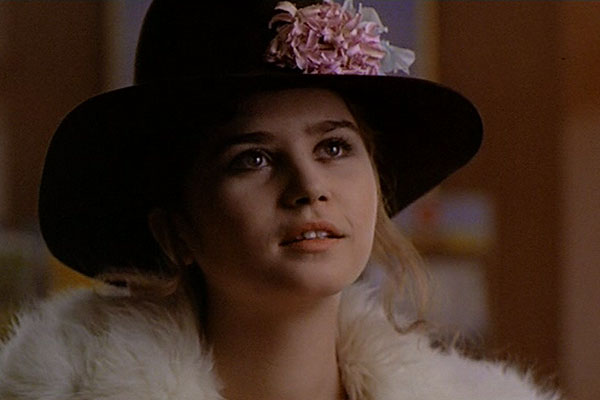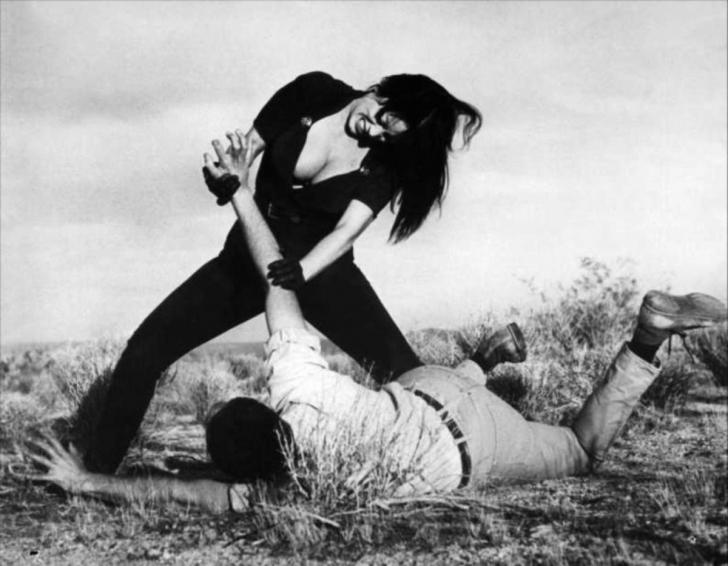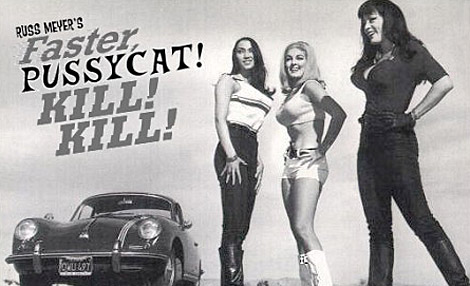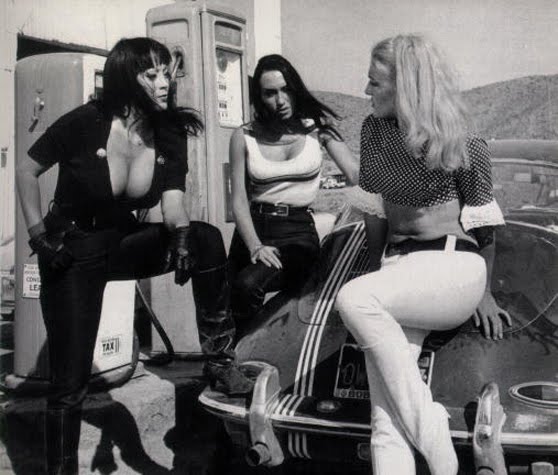The Way Of All Flesh
By David McGee
Early February was certainly a cruel month for former sex kittens. Maria Schneider (Feb. 3), Lena Nyman (Feb. 4) and Tura Satana (Feb. 4)—stars, respectively, of Last Tango in Paris, the I Am Curious (Yello) (Blue) films, and Faster, Pussycat! Kill! Kill—all passed away within a day of each other, leaving mixed legacies in their wake.
'Maria, Don't Worry, It's Just a Movie’
Maria Schneider was the most notorious of the trio, having openly declared herself bisexual after Last Tango was released in 1972 and flaunting her fame as a wild child given to drug and alcohol binges. Only 19 at the time director Bernardo Bertolucci cast her alongside Brando—she got the job because pregnancy derailed Bertolucci’s first choice, the enigmatic beauty Dominique Sanda, who had been so mesmerizing in the director’s Nazi-era drama The Conformist—Schneider became a global sensation for her brazen performance with her male counterpart, who was coming off the biggest success of his long career, The Godfather. Playing Jeanne, a Parisian lass engaged to rather dull young film director, she accepts an offer from Brando’s brutish Paul to engage him in anonymous sexual encounters in an empty Paris apartment he rents in the aftermath of his own marriage having fallen apart. Whatever the film has to say about sexual dynamics, dominant-submissive relationships and fashion—and Jeanne is always interestingly attired (when she’s not naked, that is—at the website Refinery29) Sarah Maher waxes near-euphoric over Schneider’s [Jeanne’s] choice of outfits, noting: Her personal dramas are played out in an empty apartment with a belted micro mini under a mink strewn coat. With hair left curly or pinned under her flowered fedora, Jeanne pairs leather stacked heel or flat riding boots with a brown quilted leather bag and wraps friendship beads around a simple silver bangle. Jeanne likes to apply dark eyeshadow naked except for a black scarf and cluttered sink top (but don't we all?), plays la musique pop on vinyl wearing a loose knit top, and gets creative in a long knitted scarf and cute fly-button denim flares. Overwhelmed by degradation, Jeanne downs whisky in a plaid fitted blazer and finally puts an end to her sexy issues and destructive double life.—Last Tango in Paris, and Maria Schneider’s film career are remembered mostly for one scene that did more for butter than anything since hot biscuits, when Paul employs it as a lubricant for anal sex.
In a 2007 interview with London’s Daily Mail, Schneider revealed profoundly bitter feelings she still harbored towards both Brando and Bertolucci for what happened on the set in the famous butter scene.
"That scene wasn't in the original script,” she said, “The truth is it was Marlon who came up with the idea. They only told me about it before we had to film the scene and I was so angry. I should have called my agent or had my lawyer come to the set because you can't force someone to do something that isn't in the script, but at the time, I didn't know that.
“Marlon said to me: 'Maria, don't worry, it's just a movie,' but during the scene, even though what Marlon was doing wasn't real, I was crying real tears.
"I felt humiliated and to be honest, I felt a little raped, both by Marlon and by Bertolucci. After the scene, Marlon didn't console me or apologize. Thankfully, there was just one take."
Schneider went on to appear in some two dozen mostly French movies, none garnering near the international attention of Last Tango. Even her solid performance opposite Jack Nicholson in Michelangelo Antonioni’s The Passenger in 1975 failed to bring about further juicy roles in the ensuing years. Emotional problems plagued her throughout her life; she attempted suicide once, and admitted herself to a mental hospital for a time. She continued acting, however, and made what was her final appearance on film in director Josiane Balasko’s saucy 2008 French romp, Cliente, a story about a married male construction worker who leads a double life as a prostitute servicing rich ladies. After battling cancer for many years, Maria Schneider died in Paris on February 4, at age 58.
***
‘It Was Such a Quarrel About That Movie!’
Lena Nyman preceded Schneider in infamy by five years, as the star of the sexually explicit Swedish film I Am Curious (Yellow) and its sequel, I Am Curious (Blue) [Note: yellow and blue are the colors of the Swedish flag.], both directed by Vilgot Sjöman. Hardly anyone remembers what was happening when the actors weren’t naked and having sex on screen, but the story of both films centered on Nyman’s Lena character, a 20-year-old searcher trying to figure out what life really means. She interviews people about their everyday lives and feelings, and experiments herself with meditation and yoga, unconventional relationships and political activism. In a conceit that predates by six years Francois Truffaut’s use of it in Day For Night in 1973, the crew filming the movie becomes part of the movie, as the story cuts back and forth from the set to Lena’s probings (it is the crew members, in fact, who show Lena her first yoga positions). Dr. Martin Luther King appears briefly, in a snippet of an interview filmed in March 1966 when he was in Stockholm with Harry Belafonte hoping to muster Sweden’s support for the American Civil Rights Movement. The sex scenes piqued the interest of the United States Custom Service, which in January 1968 declared the movie obscene and banned its release in the States. That November a federal appeals court ruled it was protected by the First Amendment and allowed its release—whereupon it made $5 million in its first six months in the theaters and for 23 years thereafter was the most successful foreign film in the United States.
Just as Ms. Schneider worked almost exclusively in French films after Last Tango, Ms. Nyman appeared in Swedish productions for the rest of her career, in both film and TV, more than 50 productions, in fact, including a memorable part in Ingmar Bergman’s Autumn Sonata in which she played the mentally impaired sister to Liv Ullmann’s celebrated pianist.
I Am Curious (Blue) with Sonja Lindren and Lena NymanWith the 1972 releases of Last Tango in Paris and the hardcore pornographic films Deep Throat, Behind the Green Door and 1973’s The Devil In Miss Jones, I Am Curious (Yellow) faded into cultural oblivion, seeming tepid even by the softcore standard of Last Tango. I Am Curious (Yellow) did, however, manage one last acknowledgement of its infamy. In the October 1971 issue of The Amazing Spider-Man, Gwen Stacy suggests she and Peter Parker go see the movie, if he promises to cover her eyes “during the spicy parts.”
Ms. Nyman died on February 4, following a long illness, at age 66. She was born on May 23, 1944, in Stockholm and was a student at the National Theater School of Sweden when she landed the female lead in I Am Curious (Yellow).
In an interview with the New York Times in 1974, Ms. Nyman professed to be surprised by all the furor aroused by her first movie. “You know, some people get shocked about sex. I was shocked that everyone was so shocked. It was such a quarrel about that movie. Wow!
“You could believe nobody in Sweden had ever seen a naked man or woman.”
***
Tura Satana: ‘I Was Getting Rid Of a Lot Of Anger’
Like Maria Schneider and Lena Nyman, Tura Satana wrote her name large in pop culture history on the basis of a single film, the 1965 Russ Meyer exploitation scorcher, Faster, Pussycat! Kill! Kill! Unlike other Meyer films, though, Faster, Pussycat! traded less on nudity than on the delirious spectacle of tough, buxom, assertive women portraying a gang of go-go dancers who go on a crime spree after kidnapping a couple, murdering the boy and forcing the girl to join them in their lawless exploits. Along the way Satana had plenty of opportunities to ride roughshod over the male of the species and she chewed up the scenery when her time came to do so.
“I was getting rid of a lot of anger,” she told a reporter from the San Francisco Bay Guardian. “A lot of things as I was growing up and as a young girl—that anger I kept inside of me all those years—I think I finally let it loose.”
A pithy review of Faster Pussycat posted at the website of the IFC Center reveals a largely unknown legacy spawned by the Meyer classic: “A huge cult hit in 1965, Faster Pussycat! Kill! Kill!’s success inspired legendary gay porn director Joe Gage to start thinking of making his own sex filled B-movies, including Kansas City Trucking Company, a landmark in gay porn. Don’t miss this rare film screening of Meyer’s most influential film, a cornerstone of both camp and punk culture, and certain to turn everyone on, the boys and the girls!”
‘I don’t care how big the guy is, you can bring him down.’ Tura Satana talks about her rough childhood, about learning to defend herself, about her quixotic life, working with Russ Meyer (‘nobody has sex until the filming was over’) and the good that’s come from Faster, Pussycat! Kill! Kill!Meyer described the exotic looking Satana as “half-Cherokee, half-Japanese,” which was at least half right. Her father was of Japanese and Filipino descent, her mother Cheyenne Indian and Scots-Irish. Tura Luna Pascual Yamaguchi was born on the Japanese island of Hokkaido. The family moved to California prior to the start of WWII, and subsequently the young girl spent part of her childhood in the Manzanar internment camp for Japanese-Americans in California. After the war’s end and the family’s release, they relocated to Chicago. Well developed beyond her years, Tura claimed she was raped by five men when she was nine years old, and wound up in reform school after the judge determined she was at fault for tempting her attackers. She eventually became a nomad, wandering from town to town, apparently, working as a go-go dancer and/or nude model to support herself. She got a break in Hollywood when Billy Wilder cast her in a supporting role in his 1963 comedy Irma La Douce, starring Jack Lemmon and Shirley McLaine, and two years later she landed the starring role in the Meyer film. Unfortunately, Russ Meyer films were poorly distributed, and there was no chance for any of his stars to become household names. In the ‘60s Sultana worked steadily in television, frequently popping up on many of the decade’s coolest shows, including Burke’s Law (a natural fit for her) and The Man From U.N.C.L.E. Alas, her movie roles tended towards parts in The Astro-Zombies (1968) and Mark of the Astro-Zombies (2002), both films directed by cult favorite Ted V. Mikels.
Cause of death was believed to be heart failure. She was either 72 or 75, depending on which birth dates are to be trusted. She is survived by two daughters, Kalani and Jade, and two sisters, Pamela and Kim.
Faster, Pussycat! Kill! Kill!
A review by Gary Morris
Stand back when ballooned-up, mascara-drenched go-go girls leave the confines of their cages for a murderous desert rampage!
A cornerstone of both camp and punk cultures—no mean feat—Faster Pussycat Kill! Kill! (1965) shows the thrillingly lethal consequences when aggravated go-go dancers get bored. Russ Meyer's black-and-white desert Gothic melodrama—for some viewers the crown jewel in a flashy career—opens with crazed half-naked women dancing in shadow and thrusting their tits into the camera, while a pompous male voice in overdub details the horrors of the "predatory female" for its nervous target audience—the sexually paranoid hetero male sitting alone in Pussycat theatres across the country. This film slightly predates the phenomenon of couples going out to porno films that began more or less with Deep Throat. Here Meyer is still unabashedly exploiting his own fantasies of a world of dominant, sexually supercharged women who ruthlessly take out their anxieties on any man who crosses their path—or is lured into their "web."
The ‘ballooned-up' archetypes of Faster, Pussycat! Kill! Kill!: (from left) Varla (Tura Satana), the Ethnic (Haji), the Blonde (Lori Williams): a trio of tough women who spend their leisure time outside the go-go cage driving through the California desert in tiny sports cars that look particularly ridiculous given the women's larger-then-life breasts.Pussycat features a trio of tough women who spend their leisure time outside the go-go cage driving through the California desert in tiny sports cars that look particularly ridiculous given the women's larger-then-life breasts. These thrillseekers are ballooned-up archetypes—the Blonde (Lori Williams), tough but occasionally sensitive; the Ethnic (Meyer regular Haji) with masochistic, quasi-Lesbian impulses; and supremely, Varla (Tura Satana), a '60s summation of the scary-yet-desirable dominatrix with her black stretch jumpsuit, leather boots and accessories, and troweled-on mascara across evil slits for eyes.
The classic opening minutes of Faster, Pussycat! Kill! Kill! narrated by Russ Meyer: ‘Ladies and gentlemen, welcome to violence!’ Music by the Bosstweeds.In Meyer's world, broad comedy and playful impulses predominate, and these early riot grrls are no exception. They spend the first few minutes of the film romping through the desert, insulting each other, talking really loud, racing around in their miniature sports cars, jumping fully clothed into a lake, and roughhousing. But leader Varla's demand for "ACTION!" eventually supersedes these frolics, and they corner a very straight, handsome Joe Blow and taunt him into racing with them. Of course he can't know that Varla is not only an expert racer, but an ultra-powerful judo expert whose hobbies include murder. In a brilliantly shot sequence, Varla kills him with her bare hands and the three go-go dancers kidnap his sniveling girlfriend Bunny (Susan Bernard) and take it on the lam. For good measure, they shovel sleeping pills down Bunny's throat and laughingly concoct a plan to palm her off as a rich girl in trouble that they're "escorting."
Since this is a fantasy, Meyer suspends any sense of checks and balances and, though logically these three would be easy to catch up with and arrest ("Three Dominatrixes with Huge Tits and Tiny Sportscars Sought in Murder"), they somehow elude the law and barge in on an old cripple and his two sons, who they've learned have a fortune hidden on their ramshackle desert property. One of the sons, the appropriately named "Vegetable," is a typical Meyer male buffoon—the hunk who can't fuck—and the director gets plenty of comic mileage counterpointing the oversexed girls' longing for Vegetable with their inability to land him. The old man (Stu Lancaster) is another stock character, the wizened cripple-with-a-secret who can't fuck.
Faster, Pussycat! Kill! Kill!: The gals take it to an unsuspecting couple. ‘I don’t know what your point is—‘ ‘The point is of no return, and you’ve reached it!’At which point Tura Satana delivers the death blow.Meyer's subtle detailing of these relationships makes Faster Pussycat look like a William Inge play, with a warped quasi-family slowly destroying each other. Of course, the director doesn't neglect the cheesecake; he includes consciously gratuitous shots of the girls showering, strapping on their bras, and so on. Yet there is surprisingly little real (well, simulated real) sex in this one; Meyer exploits the goings-on more for their dramatic and violent possibilities. Eventually all the secret tragedies of the past that drive these characters emerge, and the ultra-violent ending (best not to reveal), with its razor-sharp editing and tight framing, is one of the director's most dynamic.
Trivia to keep in mind while watching Faster Pussycat: the score is classic '60s trash by the Bostweeds, now available on CD; the Cramps did a cover version of the title song; most of the women in the film, including the little goody two-shoes Bunny, were ex-Playboy playmates; Tura Satana became a dental hygienist ("open wider, you sonofobitch!"); it has a little-known companion film (the male version) called Motor Psycho; and of course Russ Meyer is a genius and this film is a masterpiece.
Published April 1996 at the Bright Lights Film Journal.
Copyright 2011 by Gary Morris
THE BLUEGRASS SPECIAL
Founder/Publisher/Editor: David McGee
Contributing Editors: Billy Altman, Laura Fissinger, Christopher Hill, Derk Richardson
Logo Design: John Mendelsohn (www.johnmendelsohn.com)
Website Design: Kieran McGee (www.kieranmcgee.com)
Staff Photographers: Audrey Harrod (Louisville, KY; www.flickr.com/audreyharrod), Alicia Zappier (New York)
E-mail: thebluegrassspecial@gmail.com
Mailing Address: David McGee, 201 W. 85 St.—5B, New York, NY 10024
Founder/Publisher/Editor: David McGee
Contributing Editors: Billy Altman, Laura Fissinger, Christopher Hill, Derk Richardson
Logo Design: John Mendelsohn (www.johnmendelsohn.com)
Website Design: Kieran McGee (www.kieranmcgee.com)
Staff Photographers: Audrey Harrod (Louisville, KY; www.flickr.com/audreyharrod), Alicia Zappier (New York)
E-mail: thebluegrassspecial@gmail.com
Mailing Address: David McGee, 201 W. 85 St.—5B, New York, NY 10024






